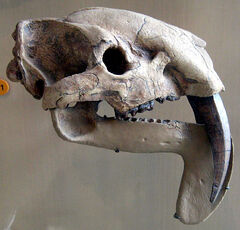| Thylacosmilus | |
|---|---|

| |
| A cast of a Thylacosmilus atrox skull | |
| Scientific classification | |
| Kingdom: | Animalia |
| Phylum: | Chordata |
| Class: | Mammalia |
| Infraclass: | Metatheria |
| Order: | †Sparassodonta |
| Family: | †Thylacosmilidae |
| Genus: | †Thylacosmilus Riggs, 1933 |
| Species: | T. atrox |
| Binomial name | |
| Thylacosmilus atrox | |
| Synonyms | |
|
T. lentis Riggs, 1933 | |
Thylacosmilus is an extinct genus of sabre-toothed sparassodont which was endemic to South America during the Neogene period. It is known for looking similar to the machairodonts, an unrelated family of felids, due to it possessing a pair of "sabre teeth".
Despite popular belief, Thylacosmilus is not related to machairodonts or any other type of felid. Instead, sparassodonts are a sister taxon to the more closely related marsupials. Their similarities were caused by convergent evolution.
Description
Thylacosmilus' most notable features were a pair of sabre-like teeth. The roots of these teeth grew throughout the animal's life. Its cervical vertebrae was very strong and closely resembled those of machairodonts to some extent. Recent biomechanical research and tests have revealed that Thylacosmilus' bite force was significantly weaker than that of a modern leopard, suggesting that its jaw muscles did not play a large part in subduing its prey.
Its skull was similar to Smilodon and further analysis has lead scientists to believe that Thylacosmilus killed its prey but immobilising it and subsequently afflicting deep bite wounds to the soft tissue until the prey died.
Body mass estimates suggest that Thylacosmilus weighed between 80 to 120 kg, which is similar to the weight of a modern jaguar or leopard. This would make it one of the largest carnivorous metatherians.
Decline and extinction
Old and outdated sources suggested that the extinction of Thylacosmilus was caused by competition with machairodonts such as Smilodon. However, recent studies suggest that that is not the case. Thylacosmilus became extinct during the late Pliocene whereas the earliest South American Smilodon fossils date back to the middle Pleistocene epoch; the two genera were separated by 1.5 million years. There's another theory stating it went extinct during the Great American Interchange, where the two fauna from North America and South America met eachother. It may have been that during this time, carnivores that entered South America which was where Thylacosmilus lived, may have had very similar roles and outcompeted the metatherian to extinction, possibly due to packs or possessing more effective weaponry suited to predatory roles.